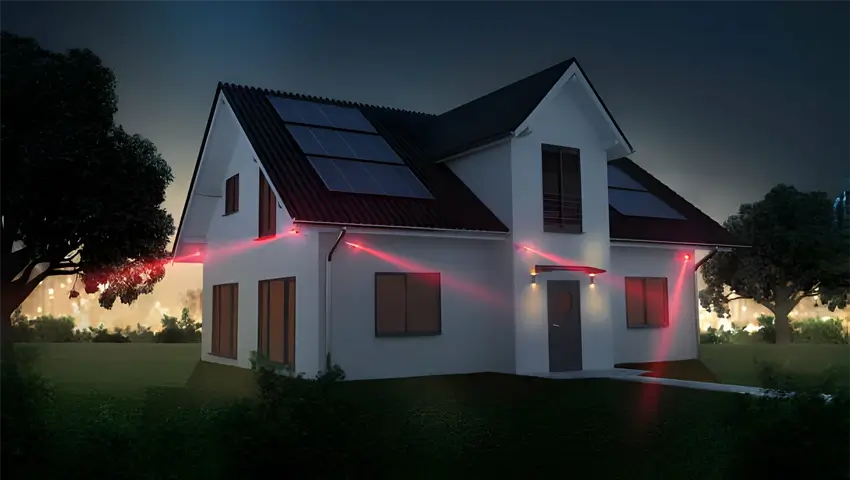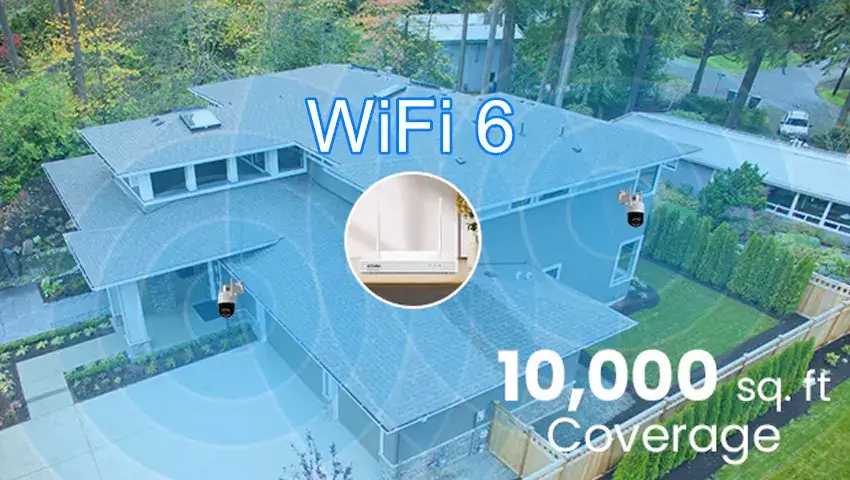A recently published report by SafeWise, ‘The State of Safety in America,’ revealed that burglaries continue to be a significant concern among Americans. This concern is entirely valid, given the alarming statistics that suggest new burglaries occur every two minutes in the U.S. However, all hope is not lost, as there are practical steps one can take to protect their property and reduce the risk of becoming a victim of this devastating crime.
Contents
Key Burglary Statistics
Burglary continues to be a major concern for Americans, and the FBI’s extensive crime database tracks such data in the United States, providing eye-opening insights into burglary statistics and home invasion data.
- In 2022, 847,522 burglaries were reported to the FBI, while 239,137 counts happened during the day at the victim’s residence, and 184,846 counts happened at night at the victim’s residence. (FBI Crime Data)
- In 2022, total stolen property value in the U.S. was estimated at $463,576,405,747, with only $38,983,319,655 of that value recovered. (FBI Crime Data)
- Between the first half of 2022 and the first half of 2023, residential burglary rates dropped by 3.8 percent, as reported by the Council on Criminal Justice. (Council on Criminal Justice)
- Homes without a security system are 300 percent more likely to be burglarized. (Alarms.org)
- 50 percent of burglars live within two miles of their target residence. (ADT)
- The average loss from a home burglary is approximately $2,661, as per SafeWise statistics. (SafeWise)
- Most burglaries occur in the summer. (Department of Justice)
- Approximately 60 percent of burglars said they would seek an alternative target if an alarm system were on-site at their initial target. (UNC Charlotte)
- 41 percent of burglaries are spur-of-the-moment, while 12 percent are planned in advance. (UNC Charlotte)
- Both men and women are at nearly-equal risk of being the victim of burglary, with men slightly more at risk (54 percent of burglary victims are men). (FBI Crime Data)
What Is Burglary And Home Invasion?
In criminal law, burglary is a specific crime involving illicit entry into an establishment with the intent to commit an additional felony or theft. Often known as “breaking and entering,” the act does not need to be physically violent. Burglaries can occur in any premises, including businesses, homes, and airplanes.
On the other hand, home invasion, a more severe form of burglary, involves breaking into an occupied residence with the intent to terrorize, harm, or commit additional crimes against the residence’s occupants.
Burglary has different degrees of severity according to the law, with first-, second- and third-degree burglaries typically classified as felonies, and fourth-degree burglary considered a misdemeanor. The exact degrees of burglary and their associated penalties vary by state.
- First-degree burglary is the most serious and usually involves possession of a deadly weapon with intent to perpetrate theft or violence against the occupant.
- Second-degree burglary is similar to first-degree burglary and involves entering a non-residence like a business premise or buildings detached from homes, such as sheds.
- Third-degree burglary usually involves a break-in without violent consequences.
- Fourth-degree burglary generally involves removing items from areas adjacent to homes and businesses, such as fenced-in yards.
Burglary statistics over time
Burglary, a form of home invasion, has evolved as a specific and defined crime in the United States, with varying severity. FBI data indicates a small, steady decline in the number of burglaries over the past several years.
| Year | Burglaries | Burglaries to residential homes |
|---|---|---|
| 2022 | 847,522 | 57% |
| 2021 | 671,648 | 60% |
| 2020 | 940,358 | 62% |
| 2019 | 1,011,890 | 68% |
| 2018 | 1,116,963 | 69% |
What you need to know about burglary
The declining burglary rate in the United States is good news for homeowners, as it is currently less than one-fifth of what it was in 1980.
When do burglaries happen?
Contrary to popular belief, most burglaries occur during the day, when homeowners are at work and children are at school. Burglars frequently strike between 10 a.m. and 3 p.m., with a spike in activity around lunchtime, as per ADT reports. These statistics underline the importance of a surveillance system that can monitor the property promptly and offer real-time alerts of any potential intrusions, regardless of the time of day.
Urban areas are more likely to experience burglaries, as crime rates are generally higher in urban than rural areas. The largest U.S. cities are three to four times more susceptible to both property and violent crimes than rural areas.
According to a previous study by the Justice Department, burglary victims knew the burglar in 30 percent of cases. In 24 percent of cases, the burglar was a stranger, but in most cases (46 percent), the burglar’s identity was never established.
Who do burglaries happen to?
The FBI’s property crime data reveals that private residential properties are most vulnerable to burglaries. The Southern states consistently show a higher risk of burglary than their Northeastern counterparts, with currency and jewelry targeted the most frequently, according to software company The Porch Group.
Based on the 2019 crime report data, rural areas are at higher risk than densely populated cities. Historically, renters have been at a higher risk than homeowners for burglary, as indicated by data from the U.S. Department of Justice. However, the gap is closing. The SafeWise 2023 State of Safety Report shows that 28 percent of renters experience property crime, compared to 27 percent of homeowners. Thus, homeowners are equally vulnerable to burglaries.
An analysis of the National Crime Victimization Survey (NCVS) by the Bureau of Justice Statistics reveals that, in 2022, households with a combined income of over 75,000 are at the lowest risk of burglary. Households with an income of less than 25,000 a year are at the highest risk of victimization overall. Furthermore, households with six or more residents are at a higher risk of burglary than those with one or two residents.
How do burglaries happen?
Although the number of burglaries has reduced significantly in recent years, understanding their modus operandi can guide preventive efforts.
A report by home security company ADT reveals that in 34 percent of burglaries, the offenders gain access into the home by merely twisting the doorknob and walking inside, while 23 percent use an open first-floor window. These statistics highlight that access to homes during burglaries is often very straightforward, allowing criminals to enter easily. Additionally, burglaries may take much less time than expected, usually eight to ten minutes, according to the FBI.
Burglary statistics state-by-state
- Burglary statistics state-by-state can provide an understanding of the prevalence of burglaries across the country.
- In 2019, the estimated number of burglaries in every region of the country witnessed a decline of 13.5 percent in the Northeast, 10.3 percent in the Midwest, 9.4 percent in the West, and 8.4 percent in the South, according to the FBI.
- The overall decline in burglaries across the country during this period was 9.9 percent. (FBI)
- This pattern of decline is similar for all property crimes nationwide, which decreased by 4.1 percent when compared to the 2018 estimate. (FBI)
Top 10 cities with the highest total number of burglaries
Houston had the highest total number of burglaries in 2021, followed by Austin and Seattle.
| City | 2020 | 2021 | % change |
|---|---|---|---|
| Houston, TX | 15,857 | 14,664 | 7.52% decrease |
| Seattle, WA | 10,469 | 9,692 | 7.42% decrease |
| Las Vegas, NV | 7,302 | 7,822 | 7.12% increase |
| San Antonio, TX | 7,954 | 7,386 | 7.14% decrease |
| Dallas, TX | 9,439 | 6,866 | 27.26% decrease |
| Oklahoma City, OK | 6,064 | 6,237 | 2.85% increase |
| Denver, CO | 5,227 | 5,834 | 11.61% increase |
| Memphis, TN | 5,859 | 5,288 | 9.75% decrease |
| Columbus, OH | 5,577 | 4,830 | 13.39% decrease |
| Austin, TX | 4,786 | 4,797 | 0.23% increase |
(Source: FBI)
Burglary rate by region
According to FBI data, the East South Central region had the highest burglary rate in 2021, followed closely by the West South region. The Middle Atlantic region had the lowest burglary rate.
| Region | Population | Burglary rate per 100,000 | Yearly burglary rate increase |
|---|---|---|---|
| United States overall | 328, 687, 501 | 340.5 | -9.9 |
| East South Central | 19,176,181 | 469.6 | -10.7 |
| West South Central | 40,619,450 | 456.7 | -6.2 |
| South | 125,580,448 | 399.6 | -9.2 |
| Pacific | 53,492,270 | 393.9 | -9.2 |
| West | 78,347,268 | 391.4 | -10 |
| Mountain | 24,854,998 | 386.1 | -11.8 |
| West North Central | 21,426,573 | 345.5 | -7 |
| South Atlantic | 65,784,817 | 344 | -10.8 |
| Midwest | 68,329,004 | 315.2 | -10.4 |
| East North Central | 46,992,431 | 301.4 | -12.2 |
| New England | 14,845,063 | 178.1 | -14.8 |
| Northeast | 55,982,803 | 167.5 | -13.4 |
| Middle Atlantic | 41,137,749 | 163.7 | -12.9 |
(Source: FBI)
Burglary rate state by state and in Puerto Rico
New Mexico had the highest burglary rate in 2021, according to FBI data. Puerto Rico and New Hampshire had the lowest burglary rates. These rates are calculated based on the total population and burglary rate per 100,000 people, as opposed to the total number of burglaries overall.
| State | Population | Burglary rate per 100,000 | Yearly burglary rate increase |
|---|---|---|---|
| New Mexico | 2,096,829 | 696.8 | -9.4 |
| Oklahoma | 3,956,971 | 671.7 | -2.6 |
| Mississippi | 2,976,149 | 627 | -8.2 |
| Arkansas | 3,017,804 | 599.6 | -7.5 |
| Louisiana | 4,648,794 | 579 | -13.8 |
| South Carolina | 5,148,714 | 533.4 | -9.5 |
| Alabama | 4,903,185 | 531.9 | -10.7 |
| North Carolina | 10,488,084 | 529.1 | -6.2 |
| Nevada | 3,080,156 | 503.5 | -14.1 |
| Alaska | 731,545 | 487.2 | -10.2 |
| Washington | 7,614,893 | 453.6 | -15.6 |
| Tennessee | 6,829,174 | 437.4 | -11.7 |
| Missouri | 6,137,428 | 430.4 | -3.7 |
| Arizona | 7,278,717 | 394.3 | -11.2 |
| Texas | 28,995,881 | 392.8 | -4.6 |
| California | 39,512,233 | 386.1 | -7.5 |
| Hawaii | 1,415,872 | 377.2 | 6.3 |
| Ohio | 11,689,100 | 375.5 | -11.3 |
| Georgia | 10,617,423 | 372.1 | -16.5 |
| Iowa | 3,155,070 | 371.1 | -6 |
| Oregon | 4,217,737 | 349.1 | -11.6 |
| Colorado | 5,758,736 | 348.4 | -8.9 |
| Kentucky | 4,467,673 | 345.7 | -11.7 |
| Kansas | 2,913,314 | 342.7 | -22 |
| North Dakota | 762,062 | 342.2 | -5.4 |
| West Virginia | 1,792,147 | 327.9 | 0.3 |
| Indiana | 6,732,219 | 323.7 | -16.3 |
| South Dakota | 884,659 | 299.1 | 5 |
| Florida | 21,477,737 | 295.2 | -12.8 |
| Michigan | 9,986,857 | 286.1 | -10.3 |
| Minnesota | 5,639,632 | 282.4 | -2.3 |
| Maryland | 6,045,680 | 278.9 | -11 |
| Utah | 3,205,958 | 276.7 | -13.4 |
| Illinois | 12,671,821 | 271.7 | -12.1 |
| Montana | 1,068,778 | 270.1 | -13.9 |
| District of Columbia | 705,749 | 261.1 | 2.5 |
| Nebraska | 1,934,404 | 245.3 | -11 |
| Wyoming | 578,759 | 241.2 | -10.2 |
| Idaho | 1,787,065 | 219.7 | -22.9 |
| Rhode Island | 1,056,361 | 219.1 | -17.7 |
| Wisconsin | 5,822,434 | 217.6 | -10.9 |
| Vermont | 623,989 | 204.3 | -14.7 |
| New Jersey | 8,882,190 | 184.6 | -14.7 |
| Pennsylvania | 12,801,989 | 182.4 | -13.7 |
| Connecticut | 3,565,287 | 180.7 | -19.2 |
| Massachusetts | 6,892,503 | 179 | -12.6 |
| Maine | 1,344,212 | 174.8 | -13.7 |
| Virginia | 8,535,519 | 162.8 | -11.6 |
| New York | 19,453,561 | 141.9 | -11.1 |
| Puerto Rico | 3,193,694 | 134.4 | -21.8 |
| New Hampshire | 1,359,711 | 126.3 | -10.4 |
Common burglary tactics and targets
Burglars primarily target items that can be transported easily, quickly, and with little trace.
Home security company ADT has revealed that commonly stolen items include firearms, prescription drugs, electronics like phones or laptops, and valuable items like jewelry or furs.
A survey conducted by a news team of convicted burglars in New York and New Jersey revealed some of their tactics.
- As per the survey, 42 percent of burglars gain entry by breaking into an unlocked window, while 39 percent enter through an unlocked door.
- Over half of the respondents reported that alarm systems do not pose significant problems for them.
- 35 percent indicated they could finish their operation before the police arrived.
- 21 percent reported that they could disarm the system.
- 18 percent revealed they could enter in a way that would not set off alarms.
- Surprisingly, 37 percent of respondents shared that a video camera outside the house would stop them.
- 72 percent of burglars favored houses to apartments as their targets.
- 29 percent of respondents reported that they knocked on the door before attempting the burglary.
- Usually posing as a delivery person, landscaper, cable repairman, or someone looking for their dog.
- Dogs at home did not deter burglars, as some reported they bring peanut butter or treats to distract the dog.
How burglary will affect your home insurance
Homeowners’ insurance covers damages to your home and losses associated with stolen personal items, with theft being a commonly covered loss. However, there are limitations depending on the type of coverage purchased.
- Actual Cash Value (ACV) compensates for the depreciated value of stolen items, which may not fully cover replacement costs.
- Replacement Cost Value (RCV) policies, on the other hand, provide compensation for the cost of buying replacement items at today’s prices, providing a more comprehensive coverage option. A Scheduled Personal Property policy can also help ensure that expensive items like jewelry and art are covered.
- Scheduled personal property coverage is necessary for expensive items like jewelry or art, requiring you to add them to your policy for adequate protection.
- Deductible: The deductible you choose for your home insurance can significantly affect the cost of coverage. Discuss with your agent to find the right balance between your burglary risk and the cost of coverage.
Home insurance rates usually increase after a burglary claim, with the extent of the increase depending on factors like your location and the value of the claim. You can potentially minimize these increases by installing security equipment and taking advantage of available discounts.
Burglary Prevention Tips:
Protecting your home from burglaries doesn’t have to be complicated. Here are some straightforward steps you can take to reduce your risk and keep your property safe:
- Build a Strong Community: Join or start a neighborhood watch program. Informed and watchful neighbors can deter burglars. Let your neighbors know when you’ll be away so they can keep an eye out for any suspicious activity.
- Make Your Home Look Occupied: Burglars are less likely to target homes that appear to be occupied. Use timers for lights and radios to create the illusion of someone being home. If possible, leave a car in the driveway.
- Secure Your Home: Ensure all locks on doors and windows are in working order. Lock up before leaving or going to bed. Don’t forget to secure your garage door, too.
- Manage Deliveries: Have the post office hold your mail and ask a neighbor to check for packages at your door. An overflowing mailbox or visible packages can signal to burglars that you’re away.
- Maintain Your Yard: If you’ll be away for a while, arrange for someone to mow your lawn and tend to your yard. An unkempt yard can indicate an empty home.
- Avoid Hiding Spare Keys: Don’t leave spare keys in obvious places like under doormats or in flower pots. Burglars know where to look.
- Limit Social Media Sharing: Refrain from posting your travel plans or sharing that you’ll be away from home on social media. This information can be used by burglars to target your home.
- Install Exterior Lighting: Good exterior lighting can deter burglars. Consider installing motion-sensitive lights around your house.
Investing in your home’s security is a wise decision.
- Explore the range of security systems available to find one that fits your budget and needs.
- Consider installing a safe for your valuables and have a professional assess your entry doors for vulnerabilities.
- Taking these steps can greatly enhance the security of your home and give you peace of mind.
4K POE Surveillance Cameras Security Monitor Systems
- Smart Person/Vehicle Detection
- Customize Detection Zone
- 4K Starlight Night Vision
- 24/7 Video & Audio Recording
- Access Remotely & Flexibly
- Two Way Audio
Conclusion
Home burglary is a serious crime with long-lasting effects on victims. While the statistics are alarming, homeowners can take steps to reduce their risk and increase their security. Installing high-quality security cameras both inside and outside the home is one effective measure. By being proactive, homeowners can help prevent burglaries and ensure the safety of their families.






